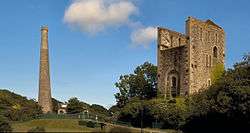East Wheal Rose
|
The preserved engine house and stack | |
| Location | |
|---|---|
 East Wheal Rose Location in Cornwall | |
| Location | Newquay |
| County | Cornwall |
| Country | United Kingdom |
| Coordinates | 50°21′43″N 5°02′28″W / 50.362°N 5.041°WCoordinates: 50°21′43″N 5°02′28″W / 50.362°N 5.041°W |
| Production | |
| Products | Lead, also silver and zinc |
| History | |
| Opened | ? |
| Closed | 1886 |
East Wheal Rose was a metalliferous mine about a kilometre south east of the village of St Newlyn East, which is about 5 km inland from Newquay on the north Cornwall coast, United Kingdom. The country rock at the mine was killas and its main produce was lead ore (galena), but as is usual when mining this mineral, commercial quantities of silver and zinc were also found and sold.
The two main lodes, called Middleton's Lode and East Lode, trended north-south. The ore they contained was in places very soft and loose and the killas was also not a particularly strong rock, necessitating extensive underground timbering, particularly in the shafts.[1] Records show that the mine had more than twenty shafts on the two lodes,[2] and the deepest workings were at 150 fathoms (900 ft).[1]
Disaster in 1846
The mine was sited in the valley of a small stream at the point where it opens out into a natural bowl and is virtually surrounded by hills. The outlet from this bowl is through a narrow ravine through which the stream flows into the River Gannel. Just after noon on 9 July 1846 there was an unusually heavy thunderstorm which lasted an hour and a quarter. Captain Middleton, the mine manager, reported that within five minutes of it starting to rain, water was flowing down the hills in torrents. Despite efforts by the men on the surface to dam or divert the water from the shafts the mine was rapidly flooded up to the 50 fathom (300 ft) level, and of the estimated 200 miners who were underground at the time, 39 were drowned.[2][3]
After the disaster, villagers of St. Newlyn East worked together and dug a pit in remembrance of the miners who died. The pit is still there today, and has been used frequently for church meetings and tea gatherings etc. When the pit was actually made, it was also used for Cornish wrestling, and was recently re-dug and made more usable with funding from the National Lottery Fund.
Later history
Despite the setback the mine soon reopened and continued producing ore until it closed in 1886. Between 1845 and 1885 it produced 48,200 tons of 62% lead ore, 212,700 ounces of silver and 280 tons of zinc ore.[1]
Today, apart from the preserved engine house and chimney stack, there are few remains of the mine visible and the site is a tourist attraction with a boating lake, crazy golf etc. It is at one end of the Lappa Valley Steam Railway which follows part of the route of one of the Treffry Tramways that was opened in 1849 for hauling ore from the mine to Newquay.
References
- 1 2 3 Dines, H. G. (1956). The Metalliferous Mining Region of South-West England. Volume I. London: HMSO. pp. 499–501.
- 1 2 "Perranzabuloe Mining District - East Wheal Rose". Cornwall in Focus. Retrieved 2009-07-24.
- ↑ "The West Briton Newspaper: transcript of article from 17 July 1846.". Julia Mosman & Rita Kopp. Retrieved 2009-07-24.
